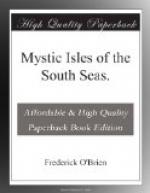We passed the gorge of Fautaua, where Fragrance of the Jasmine and I had had a charmed day. The pinnacles of the Diadem were black against the eastern sky. Aorai, the tallest peak in sight, more than a mile high, hid its head in a mass of snowy clouds.
Not far away was the mausoleum of the last king of the Society Islands, Pomare the Fifth, with whose wide-awake widow, the queen, I had smoked a cigarette a day ago. It was a pyramid of coral, a red funeral-urn on top, and a red P on the facade. Pillars and roof were of the same color, and a chain surrounded it. The tomb was rococo, glaring, typical of the monuments in the South Seas where the aboriginal structures of beauty or interest were destroyed by the missionaries to please their Clapham Seminary god. Pomare, who had been the victim of French political chicane, enjoyed now but one privilege. If his spirit had senses, it heard the lapping of the waves upon the beach of the lagoon across which his ancestor, the first Pomare, had come from Moorea to be a king.
We left the Broom Road for Point Venus to see the monument to Captain James Cook, the great mariner of these seas. The only lighthouse on Tahiti is there. On that spot Cook and his astronomers had observed the transit of Venus in 1769, and it was there the first English missionaries landed from the ship Duff to convert the pagan Tahitians. Cook has a pillar, with a plate of commemoration, in a grove of purau-trees, cocoanuts, pandanus, and the red oleander; Cook who is an immortal, and was loved by a queen here.
We left behind Paintua, Taunoa, Arahim, Arue and Haapape, and came to a shore where no reef checked the waves in a yeasty line a mile or less from the beach. The breakers roared and beat upon a black shore, strangely different from the Tahitian strand that I had seen. For miles a hundred feet of sable rocks, pebbles, some small and others as big as a man’s hand, lay between the receded tide and the road, and all along huge islets of somber stone defended themselves as best they could against the attack of the surf. Signs of surrender showed in some, caverns and arches cut by the constant hammer of swell and billow.
Sugar-cane, vanilla, pineapples, coffee, bananas, plantation after plantation, with the country houses of Papeete’s merchants, officials, lawyers, and doctors, moved past our vehicle, and, as we increased the distance from the capital, the beautiful native homes appeared.
Simple they were, with no windows or doors, mere shelters, but cool and cheap, with no division of rooms, and no furniture but the sleeping mats and a utensil or two. Natives were seen cooking their simple meal of fish and breadfruit, or only the latter. The fire was in the ground or under a grill of iron on stones. They would not go hungry, for mango-trees lined the road, and bananas, feis, and pineapples were to be had for the taking.




